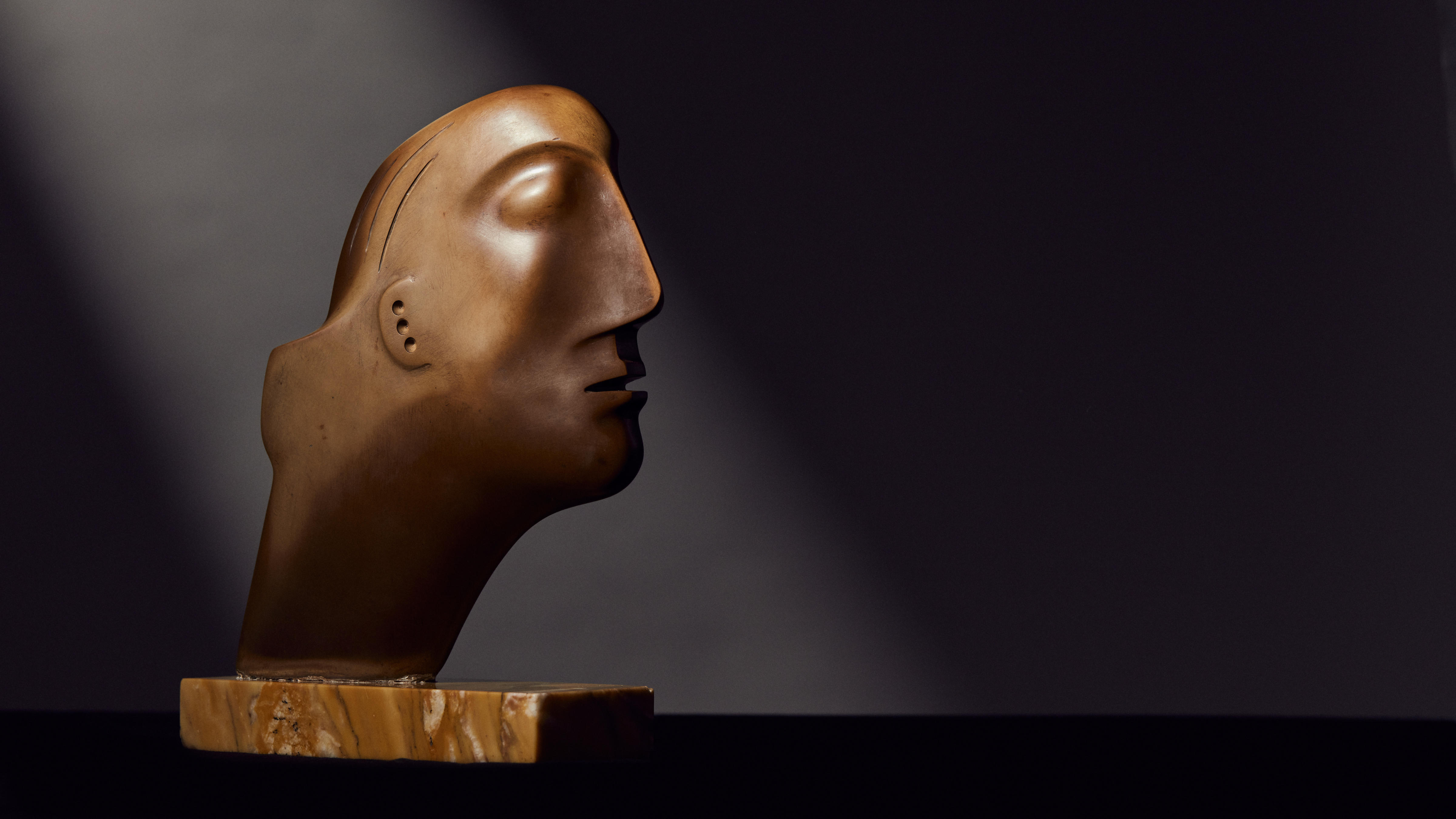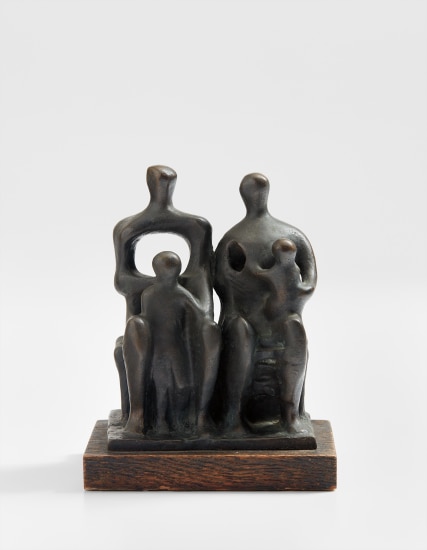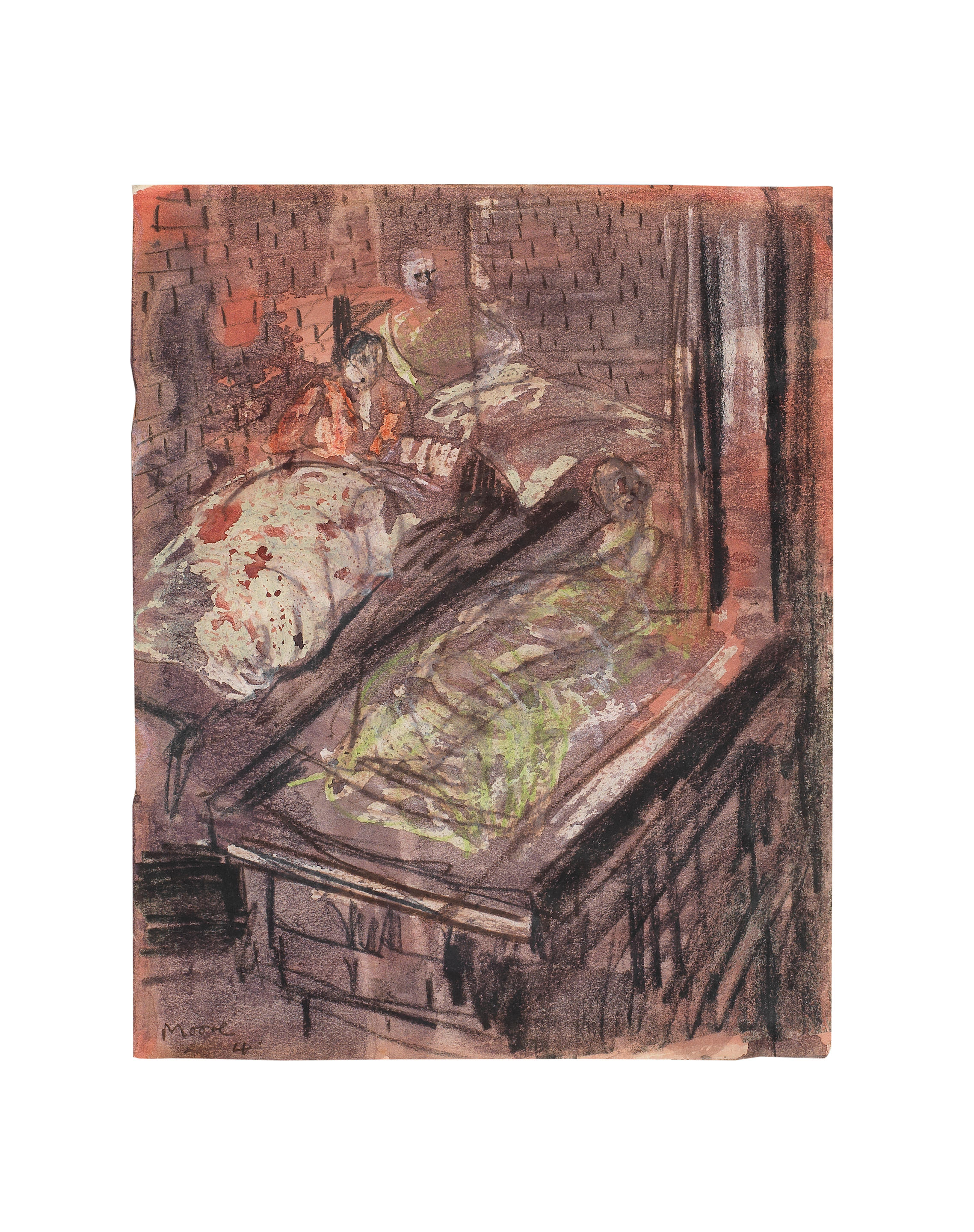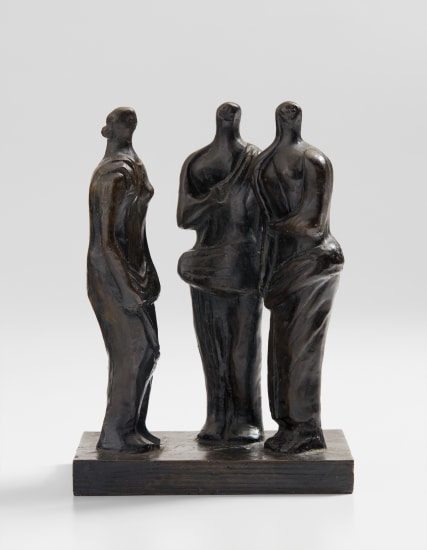Henry Moore O.M., C.H. (British, 1898-1986)Recumbent Figure bronze with a brown patina on a wooden base 13 cm. (5 1/8 in.) long (excluding the base) Conceived in 1938 and cast in bronze prior to 1948, in an edition of 9FootnotesProvenance Marion and Gustave Ring, Washington D.C. Private Collection, New York With James Goodman Gallery, New York With Waddington Galleries, London, 2004, where acquired by the family of the present owners Private Collection, U.K. Exhibited Florence, Forte di Belvedere, Henry Moore 20 May-30 September 1973 (another cast) Caracas, Museo de Arte Contemporáneo, Henry Moore; Esculturas, Dibujos, Grabados. Obras de 1921 a 1982, March 1983, cat.no.E85 (another cast) Washington D.C., Hirshhorn Museum and Sculptural Garden, Selections from the Collection of Marion and Gustave Ring, 17 October 1985-12 January 1986, cat.no.35 (this cast) Jerusalem, The Israel Museum, Focus on the Collection: Henry Moore July 2004-March 2005, cat.no.8 (another cast) Literature Robert Melville, Henry Moore Sculpture and Drawings, 1921-1969, Thames and Hudson, London, 1970, p.100, cat.no.174 (monumental stone version illustrated, pp.100-101) Franco Russoli and David Mitchinson, Henry Moore Sculpture, With Comments by the Artist, London, Arthur A. Bartley, 1981, p.74, cat.no.121 (col.ill., another cast) Exh.cat., Henry Moore; Esculturas, Dibujos, Grabados. Obras de 1921 a 1982, Museo de Arte Contemporáneo, Caracas, 1983, p.100, cat.no.E85 (col.ill, another cast) Virginia Wageman (ed.), Selections from the Collection of Marion and Gustave Ring, Smithsonian Institution Press, Washington, D.C., 1985, cat.no.35, (coll.ill., as Reclining Figure) David Sylvester (ed.), Henry Moore Complete Sculpture, 1921-1948, Lund Humphries, London, 1988, Volume 1, p.11, cat.no.184 (monumental stone version illustrated, pp.112-113, no. 191) It is alleged that James Bolivar Manson director of the Tate Gallery between 1930 and 1938, once said 'Over my dead body will Henry Moore ever enter the Tate'. Yet just one year following his retirement, the Tate (under the directorship of John Rothenstein) gladly accepted Moore's large green Hornton stone carving Recumbent Figure of 1938. Of all Moore's work perhaps, this carving (for which the present work is a maquette) came to symbolise not just Moore's output but to act as shorthand for modernity in 20th Century Britain. Recumbent Figure was commissioned by the architect Serge Chermayeff who was building himself a modernist home on the Sussex Downs. The carving was to be positioned at the intersection of Chermayeff's terrace and garden, the connection point between his contemporary architecture and the ancient rolling countryside beyond. Moore recalled 'My figure looked out across the great sweep of the Downs and her gaze gathered the horizon. The sculpture had no specific relationship to the architecture. It had its own identity and did not need to be on Chermayeff's terrace, but it so to speak enjoyed being there, and I think introduced a humanising element; it became a mediator between modern house and ageless land' (Henry Moore in Sculpture in the Open Air, British Council film, 1955, transcript reprinted in Alan Wilkinson (ed.), Henry Moore Writings and Conversations, Aldershot 2002, p.258–9). Chermayeff ran into financial woes, and Recumbent Figure was returned to the artist, from whom it was purchased by the Tate in 1939. The carving was immediately shipped to New York to be showcased at the British Pavilion of that year's World's Fair, and due to the outbreak of war this intended brief excursion turned into a several-year-long stay. The work was displayed at MOMA and this unplanned circumstance greatly bolstered Moore's reputation in North America. The museum's director wrote in 1946 'It was with great regret that we saw it leave. It had won wide esteem among the museum visitors.' (John James Sweeny, letter to John Rothenstein, 7 March 1946, Tate Public Records TG 4/9/568/1). Following Recumbe
Henry Moore O.M., C.H. (British, 1898-1986)Recumbent Figure bronze with a brown patina on a wooden base 13 cm. (5 1/8 in.) long (excluding the base) Conceived in 1938 and cast in bronze prior to 1948, in an edition of 9FootnotesProvenance Marion and Gustave Ring, Washington D.C. Private Collection, New York With James Goodman Gallery, New York With Waddington Galleries, London, 2004, where acquired by the family of the present owners Private Collection, U.K. Exhibited Florence, Forte di Belvedere, Henry Moore 20 May-30 September 1973 (another cast) Caracas, Museo de Arte Contemporáneo, Henry Moore; Esculturas, Dibujos, Grabados. Obras de 1921 a 1982, March 1983, cat.no.E85 (another cast) Washington D.C., Hirshhorn Museum and Sculptural Garden, Selections from the Collection of Marion and Gustave Ring, 17 October 1985-12 January 1986, cat.no.35 (this cast) Jerusalem, The Israel Museum, Focus on the Collection: Henry Moore July 2004-March 2005, cat.no.8 (another cast) Literature Robert Melville, Henry Moore Sculpture and Drawings, 1921-1969, Thames and Hudson, London, 1970, p.100, cat.no.174 (monumental stone version illustrated, pp.100-101) Franco Russoli and David Mitchinson, Henry Moore Sculpture, With Comments by the Artist, London, Arthur A. Bartley, 1981, p.74, cat.no.121 (col.ill., another cast) Exh.cat., Henry Moore; Esculturas, Dibujos, Grabados. Obras de 1921 a 1982, Museo de Arte Contemporáneo, Caracas, 1983, p.100, cat.no.E85 (col.ill, another cast) Virginia Wageman (ed.), Selections from the Collection of Marion and Gustave Ring, Smithsonian Institution Press, Washington, D.C., 1985, cat.no.35, (coll.ill., as Reclining Figure) David Sylvester (ed.), Henry Moore Complete Sculpture, 1921-1948, Lund Humphries, London, 1988, Volume 1, p.11, cat.no.184 (monumental stone version illustrated, pp.112-113, no. 191) It is alleged that James Bolivar Manson director of the Tate Gallery between 1930 and 1938, once said 'Over my dead body will Henry Moore ever enter the Tate'. Yet just one year following his retirement, the Tate (under the directorship of John Rothenstein) gladly accepted Moore's large green Hornton stone carving Recumbent Figure of 1938. Of all Moore's work perhaps, this carving (for which the present work is a maquette) came to symbolise not just Moore's output but to act as shorthand for modernity in 20th Century Britain. Recumbent Figure was commissioned by the architect Serge Chermayeff who was building himself a modernist home on the Sussex Downs. The carving was to be positioned at the intersection of Chermayeff's terrace and garden, the connection point between his contemporary architecture and the ancient rolling countryside beyond. Moore recalled 'My figure looked out across the great sweep of the Downs and her gaze gathered the horizon. The sculpture had no specific relationship to the architecture. It had its own identity and did not need to be on Chermayeff's terrace, but it so to speak enjoyed being there, and I think introduced a humanising element; it became a mediator between modern house and ageless land' (Henry Moore in Sculpture in the Open Air, British Council film, 1955, transcript reprinted in Alan Wilkinson (ed.), Henry Moore Writings and Conversations, Aldershot 2002, p.258–9). Chermayeff ran into financial woes, and Recumbent Figure was returned to the artist, from whom it was purchased by the Tate in 1939. The carving was immediately shipped to New York to be showcased at the British Pavilion of that year's World's Fair, and due to the outbreak of war this intended brief excursion turned into a several-year-long stay. The work was displayed at MOMA and this unplanned circumstance greatly bolstered Moore's reputation in North America. The museum's director wrote in 1946 'It was with great regret that we saw it leave. It had won wide esteem among the museum visitors.' (John James Sweeny, letter to John Rothenstein, 7 March 1946, Tate Public Records TG 4/9/568/1). Following Recumbe
.jpg)


.jpg)


.jpg)
.jpg)







Testen Sie LotSearch und seine Premium-Features 7 Tage - ohne Kosten!
Lassen Sie sich automatisch über neue Objekte in kommenden Auktionen benachrichtigen.
Suchauftrag anlegen